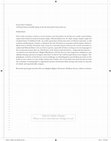Articles by Subah Dayal
Iran and the Deccan: Persianate Art, Culture, and Talent in Circulation, 2020

Journal of the Economic and Social History of the Orient, 2019
This article evaluates provincial documentary culture in the Deccan (south-central
India) prior t... more This article evaluates provincial documentary culture in the Deccan (south-central
India) prior to the incorporation of this region into Mughal Hindustan in 1687. It investigates the production and content of ʿarz-o-chehrah (muster rolls), one among
many documentary genres that verified the Mughal soldier and his horse circulating
on the front lines of uncertain conquest. From these materials, a previous generation
of scholars distilled a taxonomy of self-contained “sub-national or ethnic”
or “racial” groups (“Irani,” “Turani,” “Afghan,” “Rajput,” “Deccani,” “Indian Muslim,”
and “Miscellaneous”) that confirmed narratives about the Mughal nobility found in
chronicle histories. However, these modern construals of “ethnicity” remain difficult
to map onto the actual ones found on descriptive rolls nor do they tell us how everyday
interactions between provincial scribes and the soldier-subject transformed these
categories. Social identifications underwent changes when imperial officials, scribes,
and soldiers shared a war front with the armies of the regional, independent Deccan
sultanates. Finer degrees of specificity characterized “northern” soldiers’ labels while
“southern” cavalry were defined through broad, essentialized groupings, reflecting the
changing profiles of cavalry recruitment. By analyzing social identifications, this article
charts the making of a pan-subcontinent system of soldier recruitment wherein
the state-making processes of northern and southern India began to mirror each other,
widening the ways of defining and seeing the ‘Mughal’ soldier. This unique piece of
paper bound two individual creatures, man and horse, whose identities were both
separate and united, into a mutually-dependent relationship. These double portraits
of man and horse functioned as proxies for pay slips and not simply as pre-modern
identification cards. In doing so, they also provide a window into one instance of the
uneven, ambiguous professionalization of mercenary-soldiers taking place across the
early modern world.

Comparative Studies of South Asia, Africa, and the Middle East, 2017
This article examines a literary circuit of poets and chroniclers in the Deccan (south central In... more This article examines a literary circuit of poets and chroniclers in the Deccan (south central India) region that formed around an Iranian émigré, Mustafa Khan Lari (d. 1648), using a largely neglected versified history in Dakkani Urdu. An earlier generation of historians drew on Persian materials, as well as Dutch and Portuguese archives, to illustrate the role of Iranians as statesmen and merchants. However, Dayal turns to Persian chronicles and a maṣnavī or narrative poem written in the courtly vernacular to understand Mustafa Khan’s role as a literary patron, especially of history writing across two languages in the seventeenth-century Deccan. This literary circle of poets and chroniclers—along with their patron—circulated across Safavid Iran, Mughal Hindustan, and the Deccan; they forged new allegiances and affinities during a period of conquest and chose to observe the world around them in new tongues. The polyphonic activities of this literary circuit challenge an ethnolinguistic parochialism pervasive in the study of court culture in early modern South Asia. Further, the circuit shows how itinerant literati used the technique of ethnography to apprehend enemies and friends while moving with armies in a period of volatile and unpredictable conquest.
Keywords: patronage networks, Deccan, Mughal, Bijapur, Persianate, Dakkani, literary cultures, Iranians
Conference Presentations by Subah Dayal
Books by Subah Dayal
Book Reviews by Subah Dayal
The Journal for Early Modern Cultural Studies, 2018











Uploads
Articles by Subah Dayal
India) prior to the incorporation of this region into Mughal Hindustan in 1687. It investigates the production and content of ʿarz-o-chehrah (muster rolls), one among
many documentary genres that verified the Mughal soldier and his horse circulating
on the front lines of uncertain conquest. From these materials, a previous generation
of scholars distilled a taxonomy of self-contained “sub-national or ethnic”
or “racial” groups (“Irani,” “Turani,” “Afghan,” “Rajput,” “Deccani,” “Indian Muslim,”
and “Miscellaneous”) that confirmed narratives about the Mughal nobility found in
chronicle histories. However, these modern construals of “ethnicity” remain difficult
to map onto the actual ones found on descriptive rolls nor do they tell us how everyday
interactions between provincial scribes and the soldier-subject transformed these
categories. Social identifications underwent changes when imperial officials, scribes,
and soldiers shared a war front with the armies of the regional, independent Deccan
sultanates. Finer degrees of specificity characterized “northern” soldiers’ labels while
“southern” cavalry were defined through broad, essentialized groupings, reflecting the
changing profiles of cavalry recruitment. By analyzing social identifications, this article
charts the making of a pan-subcontinent system of soldier recruitment wherein
the state-making processes of northern and southern India began to mirror each other,
widening the ways of defining and seeing the ‘Mughal’ soldier. This unique piece of
paper bound two individual creatures, man and horse, whose identities were both
separate and united, into a mutually-dependent relationship. These double portraits
of man and horse functioned as proxies for pay slips and not simply as pre-modern
identification cards. In doing so, they also provide a window into one instance of the
uneven, ambiguous professionalization of mercenary-soldiers taking place across the
early modern world.
Keywords: patronage networks, Deccan, Mughal, Bijapur, Persianate, Dakkani, literary cultures, Iranians
Conference Presentations by Subah Dayal
Books by Subah Dayal
Book Reviews by Subah Dayal
India) prior to the incorporation of this region into Mughal Hindustan in 1687. It investigates the production and content of ʿarz-o-chehrah (muster rolls), one among
many documentary genres that verified the Mughal soldier and his horse circulating
on the front lines of uncertain conquest. From these materials, a previous generation
of scholars distilled a taxonomy of self-contained “sub-national or ethnic”
or “racial” groups (“Irani,” “Turani,” “Afghan,” “Rajput,” “Deccani,” “Indian Muslim,”
and “Miscellaneous”) that confirmed narratives about the Mughal nobility found in
chronicle histories. However, these modern construals of “ethnicity” remain difficult
to map onto the actual ones found on descriptive rolls nor do they tell us how everyday
interactions between provincial scribes and the soldier-subject transformed these
categories. Social identifications underwent changes when imperial officials, scribes,
and soldiers shared a war front with the armies of the regional, independent Deccan
sultanates. Finer degrees of specificity characterized “northern” soldiers’ labels while
“southern” cavalry were defined through broad, essentialized groupings, reflecting the
changing profiles of cavalry recruitment. By analyzing social identifications, this article
charts the making of a pan-subcontinent system of soldier recruitment wherein
the state-making processes of northern and southern India began to mirror each other,
widening the ways of defining and seeing the ‘Mughal’ soldier. This unique piece of
paper bound two individual creatures, man and horse, whose identities were both
separate and united, into a mutually-dependent relationship. These double portraits
of man and horse functioned as proxies for pay slips and not simply as pre-modern
identification cards. In doing so, they also provide a window into one instance of the
uneven, ambiguous professionalization of mercenary-soldiers taking place across the
early modern world.
Keywords: patronage networks, Deccan, Mughal, Bijapur, Persianate, Dakkani, literary cultures, Iranians